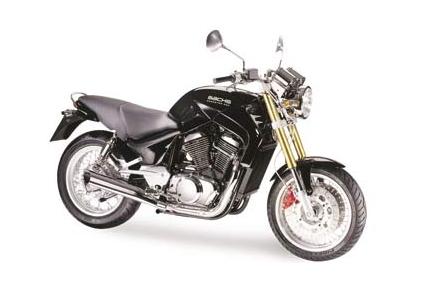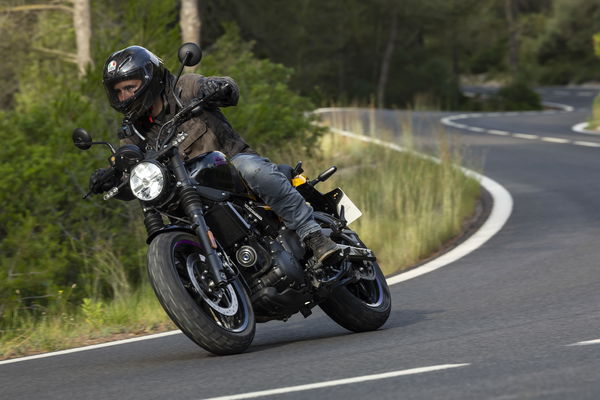GSF1200 Bandit (1996 - 2007) review
The once bad boy on the block has lost its edge to younger upstarts like the Fazer Thou, but the big Bandit is still the boss to many

Unlike tank tops, flares, centre partings and Suzuki Bandits, wheelies never go out of fashion. It doesn’t matter how much you claim to hate them, you can’t help but envy someone who can wheelie – particularly if you can’t.
If Suzuki’s Bandit isn’t encouragement enough then we don’t know what is. If you buy one of these and can’t manage a wheelie (even just a little one) take it back and demand a refund.
Ask most riders what bike they think did the most to define the 1990s and they will probably say Ducati’s 916, Honda’s FireBlade or Suzuki’s GSX-R750. Which is fair enough, as those have always been the attention grabbers, but there is a bike that had a far more subtle influence during the same period – Suzuki’s Bandit 1200.
Like a sleeper secret agent the Bandit has been doing its part to corrupt a generation of bikers into its wicked ways since it was launched in 1996. This big-bore monster was the first proper streetbike, boasting an air/oil-cooled 1,157cc motor that was very closely related to the legendary GSX-R1100’s lump while its styling was simple, naked and designed to show off this heart of metal. It wheelied like a banshee and went round corners, too. A perfect example of the philosophy keep it simple.
Throughout its eleven-year lifespan both the look and the physical components of the Bandit 1200 remained virtually unchanged. A few subtle tweaks here and there freshened it up while a stiffer chassis in 2005 provided a stopgap model for what was to come. In 2007 Suzuki took the plunge and fitted a new engine into the Bandit 1200, and not just any engine, a brand new water-cooled unit designed specifically for the bike. The Bandit was no longer living in the past, it now had its own heart as well as a new attitude. But it also had a new market positioning.
When it was launched the Bandit was the only big bore streetbike around. Now the market is flooded with them and the big Suzuki has been forced to find a new niche. Rather than chase the performance crowd with alloy frames, inverted forks, radial brakes and sharp styling the Bandit has pitched itself at the more budget-conscious buyer. With a price tag of £5,399 for a naked 1250 or £5,799 for a half-faired with ABS the Bandit is now a big-engined, classic-styled do it all machine. Is this a step in the right direction or has Suzuki sucked all the life out of a generation-defining machine?
Read more: http://www.visordown.com/road-tests/road-test-suzuki-bandit-1200-vs-1250/4410.html#ixzz1059o7KxA
Unlike tank tops, flares, centre partings and Suzuki Bandits, wheelies never go out of fashion. It doesn’t matter how much you claim to hate them, you can’t help but envy someone who can wheelie – particularly if you can’t.
If Suzuki’s Bandit isn’t encouragement enough then we don’t know what is. If you buy one of these and can’t manage a wheelie (even just a little one) take it back and demand a refund.
Ask most riders what bike they think did the most to define the 1990s and they will probably say Ducati’s 916, Honda’s FireBlade or Suzuki’s GSX-R750. Which is fair enough, as those have always been the attention grabbers, but there is a bike that had a far more subtle influence during the same period – Suzuki’s Bandit 1200.
Like a sleeper secret agent the Bandit has been doing its part to corrupt a generation of bikers into its wicked ways since it was launched in 1996. This big-bore monster was the first proper streetbike, boasting an air/oil-cooled 1,157cc motor that was very closely related to the legendary GSX-R1100’s lump while its styling was simple, naked and designed to show off this heart of metal. It wheelied like a banshee and went round corners, too. A perfect example of the philosophy keep it simple.
Throughout its eleven-year lifespan both the look and the physical components of the Bandit 1200 remained virtually unchanged. A few subtle tweaks here and there freshened it up while a stiffer chassis in 2005 provided a stopgap model for what was to come. In 2007 Suzuki took the plunge and fitted a new engine into the Bandit 1200, and not just any engine, a brand new water-cooled unit designed specifically for the bike. The Bandit was no longer living in the past, it now had its own heart as well as a new attitude. But it also had a new market positioning.
When it was launched the Bandit was the only big bore streetbike around. Now the market is flooded with them and the big Suzuki has been forced to find a new niche. Rather than chase the performance crowd with alloy frames, inverted forks, radial brakes and sharp styling the Bandit has pitched itself at the more budget-conscious buyer. With a price tag of £5,399 for a naked 1250 or £5,799 for a half-faired with ABS the Bandit is now a big-engined, classic-styled do it all machine. Is this a step in the right direction or has Suzuki sucked all the life out of a generation-defining machine?
Read more: http://www.visordown.com/road-tests/road-test-suzuki-bandit-1200-vs-1250/4410.html#ixzz1059o7KxA
| Length (mm) | 2140 |
| Width (mm) | 765 |
| Height (mm) | 1100 |
| Dryweight (kg) | 215 |
| Seats | 0 |
| Seat Height (mm) | 790 |
| Suspension Front | Telescopic, coil spring, oil damped |
| Suspension Rear | Link type, coil spring, oil damped |
| Adjustability Front | Spring preload fully adjustable |
| Adjustability Rear | Spring preload 7-way adjustable, rebound damping force 4-way adjustable |
| Tyres Front | 120/70 ZR17 |
| Tyres Rear | 180/55 ZR17 |
| Brakes Front | 6-piston calipers, dual disc brake |
| Brakes Rear | 2-piston caliper, disc brake |
| Wheelbase (mm) | 1430 |
| Ground Clearance (mm) | 130 |
| Trail (mm) | 104 |
| Cubic Capacity (cc) | 1157 |
| Max Power (bhp) | 100 |
| Max Power Peak (rpm) | 8500 |
| Torque (ft/lb) | 68 |
| Torque Peak (rpm) | 6500 |
| Bore (mm) | 79 |
| Stroke (mm) | 59 |
| Valve Gear | DOHC |
| Compression Ratio | 9.5 |
| Ignition | Electronic |
| Cooling | Air cooled |
| Fuel Delivery | Mikuni BSR36S carburettor |
| Stroke Type | Four Stroke |
| Drive | Chain |











